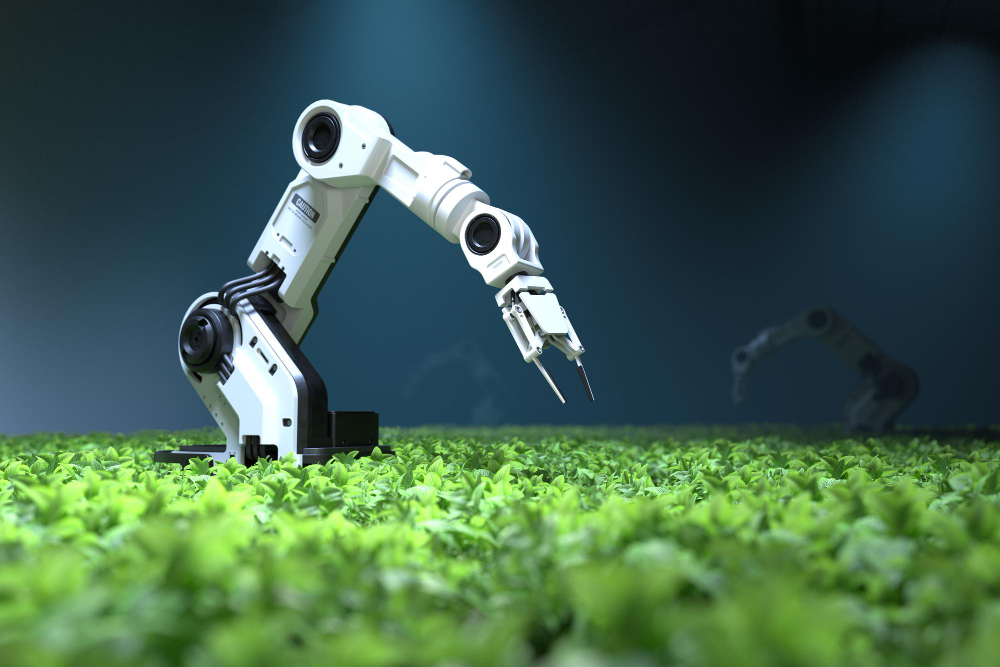The sun dips below the horizon, casting long shadows across fertile fields. But this isn’t your typical farm scene. In this field, data sensors are whispering to the cloud, drones are scanning for anomalies, and AI algorithms are quietly optimizing irrigation systems. Welcome to the future of agriculture, where AI and machine learning (ML) are transforming the way we grow our food.
1. Precision Planting
Imagine a world where seeds are sown not in neat rows, but in precise locations based on soil quality, sunlight exposure, and expected yield. AI-powered planters are making this a reality. By analyzing field data, these planters can adjust spacing, depth, and even seed type on the fly, maximizing germination and resource efficiency.
2. Predictive Maintenance
Farm equipment breakdowns can be disastrous, leading to lost time and spoiled crops. AI-powered predictive maintenance systems are changing the game. By monitoring equipment performance in real-time, these systems can identify potential issues before they occur, allowing farmers to schedule repairs proactively and avoid costly downtime.
3. Disease and Pest Detection
Early detection of crop diseases and pests is crucial for minimizing damage and ensuring bountiful harvests. AI-powered drones equipped with high-resolution cameras and image recognition software are soaring through fields, identifying diseased plants and pest infestations with unparalleled accuracy. This information allows farmers to target their pest control efforts, reducing reliance on harmful pesticides.
4. Automated Weed Control
Weeding is a time-consuming and labor-intensive task. AI-powered robots are coming to the rescue, equipped with cameras and robotic arms that can precisely identify and remove weeds without harming crops. This not only saves farmers time and money but also reduces herbicide use, contributing to a more sustainable farming future.
5. Optimized Irrigation
Water scarcity is a growing challenge for farmers worldwide. AI-powered irrigation systems are helping to conserve this precious resource. By analyzing weather data, soil moisture levels, and plant health, these systems can automatically adjust watering schedules, ensuring crops receive the precise amount of water they need to thrive while minimizing waste.
6. Yield Prediction
Predicting crop yields with accuracy can help farmers make informed decisions about planting, harvesting, and marketing. AI-powered yield prediction models are using historical data, weather forecasts, and real-time field data to generate reliable forecasts, helping farmers optimize their operations and maximize profitability.
7. Personalized Crop Recommendations
Every field is unique, with its own microclimates, soil conditions, and pest pressures. AI-powered crop recommendation systems are taking this into account. By analyzing field data and local weather patterns, these systems can provide farmers with personalized recommendations on crop varieties, planting times, and best practices, leading to higher yields and improved resource utilization.
8. Improved Market Access
Connecting farmers directly to consumers is becoming increasingly important. AI-powered market access platforms are helping to bridge the gap. These platforms use data analysis to match farmers with potential buyers based on crop type, location, and market demand, creating new opportunities for farmers to sell their produce and secure fair prices.
9. Sustainable Farming Practices
AI and ML are playing a crucial role in the development of sustainable farming practices. By analyzing data on soil health, water usage, and carbon emissions, these technologies can help farmers optimize their operations to minimize environmental impact and promote long-term sustainability.
10. Enhanced Food Security
Ultimately, the goal of AI and ML in crop management is to improve food security for all. By increasing yields, reducing waste, and optimizing resource use, these technologies can help ensure that everyone has access to safe, nutritious food.
The integration of AI and ML into crop management is still in its early stages, but the potential is vast. As these technologies continue to evolve and become more accessible, we can expect to see even more transformative changes in the way we grow our food. From personalized farm management to automated decision-making, AI and ML are poised to usher in a new era of sustainable and efficient agriculture, ensuring a brighter future for farmers and consumers alike.
Summary
Across various domains, humans have undergone significant transformations due to the integration of advanced technology, and agriculture is no exception. While technology has long played a role in enhancing agricultural practices, its importance has surged in recent times. AI/ML has emerged as a potent force, offering substantial benefits such as:
Enhanced environmental sustainability Heightened efficiency in labor, resources, and time Real-time monitoring capabilities for improved produce health and quality Smarter allocation of resources, and more The applications of AI/ML in agriculture are vast and diverse, ushering in a new era of agricultural evolution. These advancements owe much to AI/ML and other sophisticated technological enhancements.
